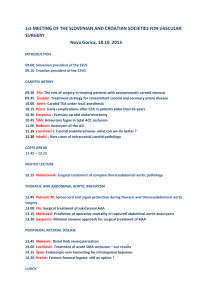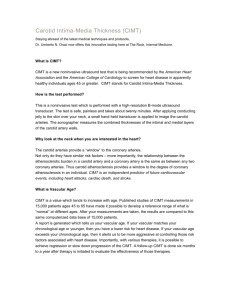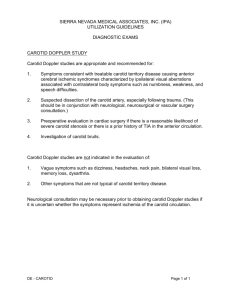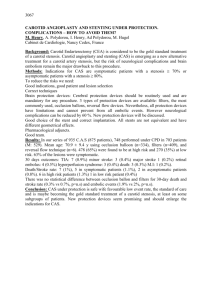Carotid Intimal-Medial Thickness - Blue Cross and Blue Shield of
advertisement
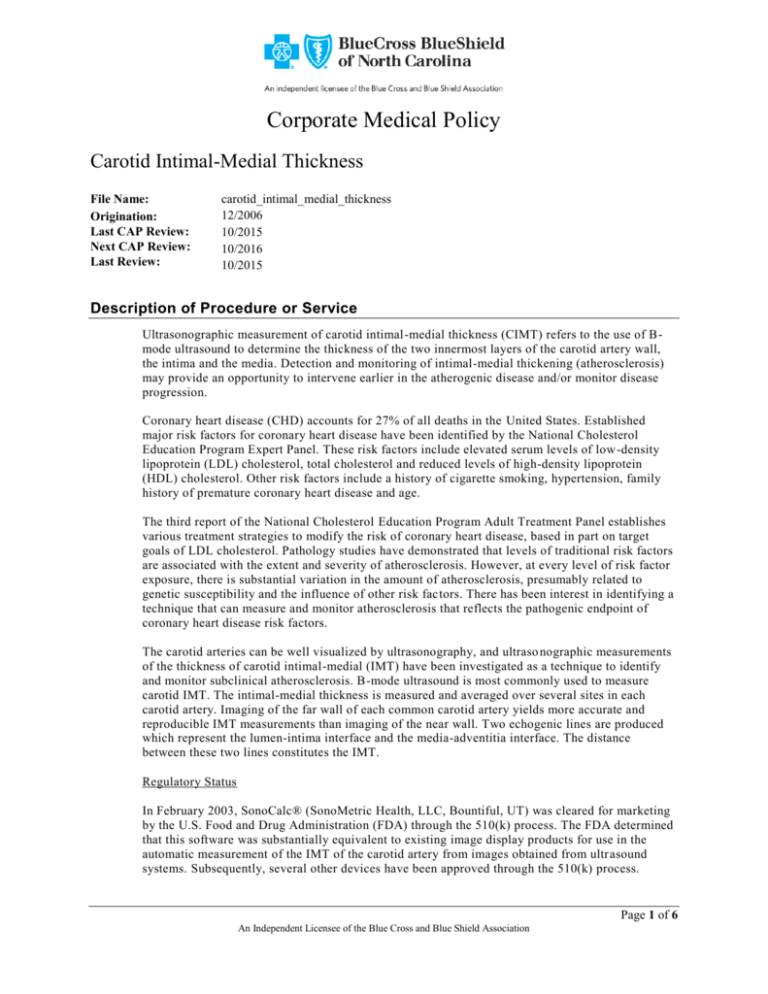
Corporate Medical Policy Carotid Intimal-Medial Thickness File Name: Origination: Last CAP Review: Next CAP Review: Last Review: carotid_intimal_medial_thickness 12/2006 10/2015 10/2016 10/2015 Description of Procedure or Service Ultrasonographic measurement of carotid intimal-medial thickness (CIMT) refers to the use of Bmode ultrasound to determine the thickness of the two innermost layers of the carotid artery wall, the intima and the media. Detection and monitoring of intimal-medial thickening (atherosclerosis) may provide an opportunity to intervene earlier in the atherogenic disease and/or monitor disease progression. Coronary heart disease (CHD) accounts for 27% of all deaths in the United States. Established major risk factors for coronary heart disease have been identified by the National Cholesterol Education Program Expert Panel. These risk factors include elevated serum levels of low -density lipoprotein (LDL) cholesterol, total cholesterol and reduced levels of high-density lipoprotein (HDL) cholesterol. Other risk factors include a history of cigarette smoking, hypertension, family history of premature coronary heart disease and age. The third report of the National Cholesterol Education Program Adult Treatment Panel establishes various treatment strategies to modify the risk of coronary heart disease, based in part on target goals of LDL cholesterol. Pathology studies have demonstrated that levels of traditional risk factors are associated with the extent and severity of atherosclerosis. However, at every level of risk factor exposure, there is substantial variation in the amount of atherosclerosis, presumably related to genetic susceptibility and the influence of other risk factors. There has been interest in identifying a technique that can measure and monitor atherosclerosis that reflects the pathogenic endpoint of coronary heart disease risk factors. The carotid arteries can be well visualized by ultrasonography, and ultraso nographic measurements of the thickness of carotid intimal-medial (IMT) have been investigated as a technique to identify and monitor subclinical atherosclerosis. B-mode ultrasound is most commonly used to measure carotid IMT. The intimal-medial thickness is measured and averaged over several sites in each carotid artery. Imaging of the far wall of each common carotid artery yields more accurate and reproducible IMT measurements than imaging of the near wall. Two echogenic lines are produced which represent the lumen-intima interface and the media-adventitia interface. The distance between these two lines constitutes the IMT. Regulatory Status In February 2003, SonoCalc® (SonoMetric Health, LLC, Bountiful, UT) was cleared for marketing by the U.S. Food and Drug Administration (FDA) through the 510(k) process. The FDA determined that this software was substantially equivalent to existing image display products for use in the automatic measurement of the IMT of the carotid artery from images obtained from ultr asound systems. Subsequently, several other devices have been approved through the 510(k) process. Page 1 of 6 An Independent Licensee of the Blue Cross and Blue Shield Association Carotid Intimal-Medial Thickness ***Note: This Medical Policy is complex and technical. For questions concerning the technical language and/or specific clinical indications for its use, please consult your physician. Policy Carotid Intimal-Medial Thickness measurement is considered investigational for all applications. BCBSNC does not provide coverage for investigational services or procedures. Benefits Application This medical policy relates only to the services or supplies described herein. Please refer to the Member's Benefit Booklet for availability of benefits. Member's benefits may vary according to benefit design; therefore member benefit language should be reviewed before applying the terms of this medical policy. When Carotid Intimal-Medial Thickness Measurement is covered Not Applicable When Carotid Intimal-Medial Thickness Measurement is not covered Ultrasonographic measurement of carotid artery intimal-medial thickness (IMT) as a technique of identifying subclinical atherosclerosis is considered investigational for use in the screening, diagnosis, or management of atherosclerotic disease. Policy Guidelines Some studies correlate increased carotid intima-medial thickness (CIMT) with many other commonly used markers for risk of coronary heart disease (CHD) and with risk for future cardiovascular events. While a 2012 meta-analysis of individual participant data by Lorenz et al found that CIMT was associated with increased cardiovascular events, CIMT progression over time was not associated with increased cardiovascular event risk. In a systematic review by Peters et al (2012), the added predictive value of CIMT was modest, and the ability to reclassify patients into clinically relevant categories was not demonstrated. The results from these studies and others demonstrate the predictive value of CIMT is uncertain, and the predictive ability for any level of population risk cannot be determined with precision. In addition, available studies do not define how use of CIMT in clinical practice improves outcomes. There is no scientific literature that directly tests the hypothesis that measurement of CIMT results in improved patient outcomes and no specific guidance on how measurements of CIMT should be incorporated into risk assessment and risk management. The existing evidence is therefore insufficient to determine the impact of this technology on net health outcome. The U.S. Preventive Services Task Force (USPSTF, 2009) stated that there was insufficient evidence to recommend the use of carotid intima-media thickness to screen asymptomatic individuals with no history of CHD to prevent CHD events. A 2013 guideline on the assessment of cardiovascular risk from the American College of Cardiology and the American Heart Association (ACC/AHA) does not recommend CIMT for routine risk assessment of a first atherosclerotic cardiovascular disease event.ACC/AHA Class III: no benefit, LOE: B. This differs from the previous 2010 version of the ACC/AHA guidelines for assessment of cardiovascular risk, which indicated CIMT might be reasonable for assessing Page 2 of 6 An Independent Licensee of the Blue Cross and Blue Shield Association Carotid Intimal-Medial Thickness cardiovascular risk in intermediate risk asymptomatic adults. Billing/Coding/Physician Documentation Information This policy may apply to the following codes. Inclusion of a code in this section does not guarantee that it will be reimbursed. For further information on reimbursement guidelines, please see Administrative Policies on the Blue Cross Blue Shield of North Carolina web site at www.bcbsnc.com. They are listed in the Category Search on the Medical Policy search page. Applicable codes: 93895, 0126T CPT 93880 describes bilateral duplex scan of extracranial arteries. Because of the detailed measurement involved in calculating carotid intimal-medial thickness, providers may elect to submit these claims with a --22 modifier (unusual procedural service). In addition, linking the CPT code to the ICD-9 code V81.0 (special screening for cardiovascular disease) may help identify claims. BCBSNC may request medical records for determination of medical necessity. When medical records are requested, letters of support and/or explanation are often useful, but are not sufficient documentation unless all specific information needed to make a medical necessity determination is included. Scientific Background and Reference Sources Simons PC, Algra A, Bots ML, Grobbee DE, van der Graaf Y. (August 1999). Common Carotid Intima-Media Thickness and Arterial Stiffness: Indicators of Cardiovascular Risk in High -Risk Patient The SMART Study (Second Manifestations of ARTerial disease). Circu lation. 1999;100:951-957 O’Leary DH, Polak JF, Kronmal RA, Manolio TA, Burke GL, Wolfson SK. (January 1999). Carotid-Artery Intima and Media Thickness as a Risk Factor for Myocardial Infarction and Stroke in Older Adults. New England Journal of Medicine. 1999;340(1):14-22 Iglesias del Sol A, Bots ML, Grobbee DE, Hofman A, Witteman JC. (June 2002). Carotid intima media thickness at different sites: relation to incident myocardial infarction. European Heart Journal, 2002; 23(12):934-940 U.S. Department of Health and Human Services, National Institutes of Health, National Heart, Lung and Blood Institute. Third Report of the National Cholesterol Education Program Expert Panel on detection, evaluation, and treatment of high blood cholesterol in adults (Adult T reatment Panel III). Final Report. NIH Publication No. 02-5215. September 2002. Retrieved November 7, 2006 from http://www.nhlbi.nih.gov/guidelines/cholesterol/atp3full.pdf BCBSA Medical Policy Reference Manual [Electronic Version]. 2.02.16, 8/17/05 BCBSA Medical Policy Reference Manual [Electronic Version]. 2.02.16, 6/11/09 National Institutes of Health (NIH). Third Report of the National Cholesterol Education Program (NCEP) Expert Panel on Detection, Evaluation, and Treatment of High Blood Cholesterol in Adults (Adult Treatment Panel III). NIH Publication No. 02-5215. September 2002. Retrieved on September 9, 2010 from http://www.nhlbi.nih.gov/guidelines/cholesterol/atp3full.pdf U.S. Preventative Services Task Force. Using Nontraditional Risk Factors in Coronary Heart Disease Risk Assessment Recommendation Statement. October 2009. Retrieved on September 9, 2010 from http://www.uspreventiveservicestaskforce.org/uspstf09/riskcoronaryhd/coronaryhdrs.htm Helfand M, Buckley D, Fleming C, et al. Screening for Intermediate Risk Factors for Coronary Page 3 of 6 An Independent Licensee of the Blue Cross and Blue Shield Association Carotid Intimal-Medial Thickness Heart Disease. U.S. Preventive Services Task Force Evidence Syntheses. Agency for Healthcare Research and Quality (US); 2009. Report No.: 10-05141-EF-1. Retrieved on September 9, 2010 from http://www.ncbi.nlm.nih.gov/pubmed/20722172. Lloyd-Jones D, Adams RJ, Brown TM, et al. American Heart Association Statistics Committee and Stroke Statistics Subcommittee. Heart Disease and Stroke Statistics-2010 Update. A Report From the American Heart Association. Circulation. 2009 Dec 17. Retrieved on September 9, 2010 from http://circ.ahajournals.org/cgi/reprint/CIRCULATIONAHA.109.192667v1 BCBSA Medical Policy Reference Manual [Electronic Version]. 2.02.16, 7/8/10 Specialty Matched Consultant Advisory Panel review 10/2010 National Institues of Health (NIH). Using Differences in Peripheral Blood Leukocyte Gene Expression to Determine Cardiovascular Disease Risk. Clinical Trial #NCT00613158 National Institues of Health (NIH). Early Detection of Atherosclerosis: a Randomized Trial in the Primary Prevention of Cardiovascular Diseases. (PRIMARIA). Clinical Trial #NCT00734123 National Institues of Health (NIH). Intima-Medial Thickness Guidance of Primary Prevention in Relatives of Patients With Early onSet Atherosclerosis (IMPRESS) . Clinical Trial #NCT01330602 Greenland P, Alpert JS, Beller GA et al. 2010 ACCF/AHA guideline for assessment of cardiovascular risk in asymptomatic adults: a report of the American College of Cardiology Foundation/American Heart Association Task Force on Practice Guidelines. J Am Coll Cardiol 2010; 56(25):e50-103. Retrieved on August 15, 2011 from http://www.asnc.org/imageuploads/CV%20Risk.pdf BCBSA Medical Policy Reference Manual [Electronic Version]. 02.02.16, 7/14/11 Specialty Matched Consultant Advisory Panel review 10/2011 BCBSA Medical Policy Reference Manual [Electronic Version]. 02.02.16, 7/12/12 Specialty Matched Consultant Advisory Panel review 10/2012 Lorenz MW, Schaefer C, Steinmetz H et al. Is carotid intima media thickness useful for individual prediction of cardiovascular risk? Ten-year results from the Carotid Atherosclerosis Progression Study (CAPS). Eur Heart J 2010; 31(16):2041-8. Den Ruijter HM, Peters SA, Anderson TJ et al. Common carotid intima -media thickness measurements in cardiovascular risk prediction: a meta-analysis. JAMA 2012; 308(8):796-803. BCBSA Medical Policy Reference Manual [Electronic Version]. 2.02.16, 7/11/13 Specialty Matched Consultant Advisory Panel review 10/2013 Medical Director review 10/2013 Goff DC, Jr., Lloyd-Jones DM, Bennett G et al. 2013 ACC/AHA Guideline on the Assessment of Cardiovascular Risk: A Report of the American College of Cardiology/American Heart Association Task Force on Practice Guidelines. Circulation 2013. BCBSA Medical Policy Reference Manual [Electronic Version]. 2.02.16, 7/10/14 Specialty Matched Consultant Advisory Panel review 11/2014 Page 4 of 6 An Independent Licensee of the Blue Cross and Blue Shield Association Carotid Intimal-Medial Thickness Medical Director review 11/2014 BCBSA Medical Policy Reference Manual [Electronic Version]. 2.02.16, 7/9/15 Lorenz MW, Polak JF, Kavousi M, et al. Carotid intima-media thickness progression to predict cardiovascular events in the general population (the PROG-IMT collaborative project): a metaanalysis of individual participant data. Lancet. Jun 2 2012;379(9831):2053-2062. PMID 22541275 Medical Director review 7/2015 Specialty Matched Consultant Advisory Panel review 10/2015 Medical Director review 10/2015 Policy Implementation/Update Information 12/11/06 New Policy issued. Ultrasonographic measurement of carotid artery intima -media thickness (IMT) is considered investigational as a technique of identifying and monitoring subclinical atherosclerosis. (adn) 11/19/07 Specialty Matched Consultant Advisory Panel review meeting 10/29/07. Policy accepted as written. (adn) Policy renamed: Carotid Intimal-Medial Thickness Study 7/20/09 Policy name changed from Common Carotid Intima-Media Thickness Study to Carotid Intimal-Medial Thickness Study. Description section revised. Policy statement revised to read: "BCBSNC does not provide coverage for carotid intimal-medial thickness studies. It is considered investigational." Statement in the When Not Covered section was revised to read: "Ultrasonographic measurement of carotid artery intimal -medial thickness (IMT) as a technique of identifying subclinical atherosclerosis is considered investigational for use in the screening, diagnosis, or management of atherosclerotic disease." Coding information added to the Billing/Coding section. (adn) 12/7/09 Specialty Matched Consultant Advisory Panel review meeting 10/30/09. No change to policy statement.(adn) 6/22/10 Policy Number(s) removed (amw) 11/23/10 Specialty Matched Consultant Advisory Panel review 10/2010. Policy Guidelines updated. References updated.(mco) 8/30/11 References updated. Policy Guidelines updated. No changes to Policy Statements. (mco) 11/8/11 Specialty Matched Consultant Advisory Panel review 10/2011. No changes to Policy Statements.(mco) 9/4/12 References updated. No changes to Policy Statements. (mco) 10/30/12 Specialty Matched Consultant Advisory Panel review 10/2012. Description section updated. Policy Guidelines updated. (mco) Page 5 of 6 An Independent Licensee of the Blue Cross and Blue Shield Association Carotid Intimal-Medial Thickness 8/27/13 References updated. No changes to Policy Statements. (mco) 11/12/13 Specialty Matched Consultant Advisory Panel review 10/2013. Medical Director review 10/2013. Removed the word “Study” from the policy title. Policy Statement revised to state: “Carotid Intimal-Medial Thickness measurement is considered investigational for all applications. BCBSNC does not provide coverage for investigational services or procedures.” Policy intent is unchanged. (mco) 8/26/14 References updated. Policy Guidelines updated. No changes to Policy Statement. (mco) 12/30/14 References updated. Specialty Matched Consultant Advisory Panel review 11/2014. Medical Director review 11/2014. Added CPT code 93895 to Billing/Coding section effective 1/1/15. No changes to Policy statement. (td) 10/1/15 Policy Description updated. Policy Guidelines updated. References updated. Policy intent remains unchanged. Medical Director review 7/2015. (td) 1/26/16 Specialty Matched Consultant Advisory Panel review 10/29/2015. Medical Director review 10/2015. (td) Medical policy is not an authorization, certification, explanation of benefits or a contract. Benefits and eligibility are determined before medical guidelines and payment guidelines are applied. Benefits are determined by the group contract and subscriber certificate that is in effect at the time services are rendered. This document is solely provided for informational purposes only and is based on research of current medical literature and review of common medical practices in the treatment and diagnosis of disease. Medical practices and knowledge are constantly changing and BCBSNC reserves the right to review and revise its medical policies periodically. Page 6 of 6 An Independent Licensee of the Blue Cross and Blue Shield Association

